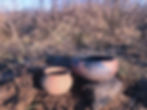Fat Earth
- Ian Thompson
- Jan 7, 2018
- 4 min read

The flicker of warm, yellow light and the sweet smell of cedar smoke radiated out into the 15 degree January night. We were camped out under the stars, just steps from a spot on our land where ancient people had set up their camps 2,000 years ago. The fire, fueled by seasoned wood cut from a fence row, not only warmed us, it also served as an open air kiln for firing Choctaw traditional pottery. The clay for making this pottery had been dug from the ground only a couple of hundred yards away from the location of our campsite. Once fired, this functional, traditional pottery was destined to serve foods that come from our farm.
The art of living locally is at the heart of today's cutting edge global efforts to make our societies more sustainable and our foods healthier. If we could all get the necessities for life from the local land, rather than transporting them half way around the globe, we would save money, increase community resilience, have more ability to ensure quality, and cut down on the fossil fuel used in transportation. Traditional culture is widely appreciated for its ability to connect us with the past. Much less often do people recognize that traditional culture also offers tremendous insights for living locally in our present day and age. The Indigenous ancestors of every person living today, no matter what corner of the globe they came from, were masters at the art of living locally. The blueprints for doing this are built into traditional cultures, Indigenous languages, and traditional worldviews around the globe. Take pottery, for example...
In the Choctaw language, clay is "lukfi nia", literally "fat earth". Choctaw ancestors have been making pottery for more than 100 generations. Clay features prominently in the Choctaw creation story. Oral history records how Choctaw people first began to learn the challenging artform of traditional pottery. As the tradition goes, a man had a river cane basket that he wanted to use for carrying liquid. He thought that it might be possible to accomplish this task if he packed the basket with "fat earth". He did so, set that basket near a fire, and got up to do something else as the clay dried. In his absence, another person came along and saw the basket caked with clay on the inside. "That basket is dirty", he thought, and so he threw it in the fire to get rid of it. As the river cane burned away,the heat changed the clay into a water-proof, stone-like material, thus creating the first piece of Choctaw pottery.
As traditional potters, when we were looking for a piece of land to set up our farm, we had hoped to find a place that had a good deposit of clay for making traditional pottery. Some of the land we looked at certainly did. It was a little tempting to let the thought of all of the fun we could have making pottery from our own clay, outweigh the more practical considerations of where to set up our farm. Our better judgement ultimately prevailed, and we bought a piece of land that had no obvious clay deposits.
Over the last couple of years, we had come across some deposits of low grade clay at different spots on this land, but had long ago given up hope of finding any that would be suitable for making pottery. Recently, we were surprised when, building a cross fence on the edge of a natural bog, the post hole digger started pulling up sticky, grey clay about two feet down in the mucky, water-filled hole.
Every clay is different. To make good pottery, a clay has to be workable enough to be formed into any shape without cracking, and it also has to contain the right minerals to properly fire. Instead of doing expensive chemical tests, the best way to tell if a natural clay is good for pottery is to make some test pots. The clay from the post hole was cleaned of roots and then mixed with sifted, burned mussel shell. It was shaped by hand into two vessels (an Alabama River Incised serving bowl and a Mississippian Plain miniature cooking jar), and allowed to slowly dry for several weeks. The two pots were fired carefully in a well-controlled bond fire. The temperature was raised incrementally over a couple of hours until it got to around 1,100 degrees Fahrenheit. At that point, the pots were glowing red like metal. Then, they were carefully cooled. The picture above shows the results of the experiment a few hours later in the early morning light, sitting on the edge of the bog where the clay to make them was dug.
Traditional pottery is fun. It's also humbling to be able to work in the same artform as our forebears. In terms of efforts to live locally, walking a couple hundred steps from the clay pit to the firing area is hard to beat. Symbolically, there is something powerful about eating food that comes from a piece of land in a hand-made traditional bowl made from clay that comes from the same land. If any of that sounds interesting to you, the Choctaw Nation Historic Preservation Department is offering free, on-going bi-weekly traditional pottery classes in Durant and Antlers. Come join us.